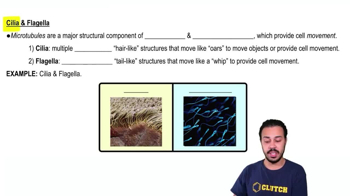Here are the essential concepts you must grasp in order to answer the question correctly.
Cilia Structure and Function
Cilia are microscopic, hair-like structures that extend from the surface of many eukaryotic cells. They are composed of microtubules arranged in a specific pattern and are involved in various functions, including movement and sensory perception. Their coordinated beating can propel cells or move fluid across cell surfaces, playing a crucial role in maintaining homeostasis.
Recommended video:
Motile Cilia
Motile cilia are specialized cilia that beat in a coordinated manner to facilitate movement. In organisms like paramecia, motile cilia help in locomotion, allowing the organism to swim through water. In multicellular organisms, such as humans, motile cilia line the respiratory tract, helping to move mucus and trapped particles out of the lungs, thus playing a vital role in respiratory health.
Recommended video:
Non-Motile Cilia (Primary Cilia)
Non-motile cilia, also known as primary cilia, serve primarily as sensory organelles. They are found on nearly all cell types and play a critical role in signal transduction, allowing cells to respond to their environment. For example, primary cilia are involved in sensing fluid flow in kidney cells, which is essential for maintaining kidney function and overall fluid balance in the body.
Recommended video:
 Verified step by step guidance
Verified step by step guidance Verified video answer for a similar problem:
Verified video answer for a similar problem:



 6:05m
6:05m